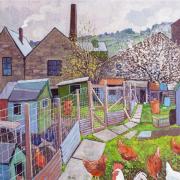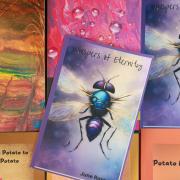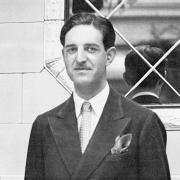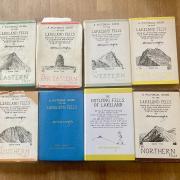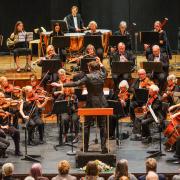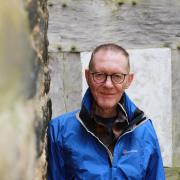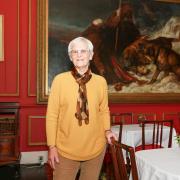A Lakeland stone hut which was home to a once-ngelected artist is being re-created in
the centre of London. Mike Glover reports
Lakeland builder Mike Hodgson has been responsible for repairing and constructing many a traditional barn.
But this month he and his crew will be causing a stir in the London arts scene when they re-create a rustic barn on the elegant neo-classical forecourt of the Royal Academy.
It will be an exact copy of the original which exists in a Langdale woodland. Known as the Merzbarn, it is was the main legacy of the neglected German-born painter and collage pioneer Kurt Schwitters.Mike supervised the gathering of authentic materials, includingthe green slate wall-stones, rotting window frames, rusty nails and moss covered roof.
The five-man team will set up the barn at the Piccadilly entrance to the Academy where the Modern British Sculpture exhibition is expected to attract a million visitors.
‘It is not a difficult job, but it will be hard work and a challenge,’ said Mike. ‘It’s good that the project is bringing the barn to the attention of people in London, and it will be a good advertisement for Langdale.’
The Lake District team will be under the direction of Dr Penelope Curtis, the director of Tate Britain, and Keith Wilson, the reader of sculpture at the Royal College of Arts. They are the joint curators of the exhibition.It opens on January 22 and it will also include works by Jacob Epstein, Henry Moore, Barbara Hepworth, Anthony Caro, Julian Opie and Damien Hirst, who has been a major supporter of the barn reconstruction.
The exhibit is a coup for Lancashire’s Littoral Arts Trust, an independent charity based in Rossendale, which has been campaigning for eight years to get recognition for Schwitters.
Director Ian Hunter said: ‘After being overlooked for almost 60 years, this artist refugee from the Nazis is about to take his rightful place in modern British art.’
Mr Hunter runs the charity with his partner Celia Larner and its main aim is to work with communities using art to bring about social and environmental change. Their priority over the years has been the restoration of the Lancashire willow-growing and basket-making industries.
They came upon the Merzbarn after working with farmers affected by the outbreak of BSE, and encouraging them to put on art displays in their own farm buildings.
They now spend much of their time working in a cottage in the same woodland as the Merzbarn, which the charity purchased eight years ago, with the help of Northern Rock.
Schwitters had a huge influence on Brit Pop artists Sir Peter Blake and Richard Hamilton as well as prominent Americans, like Robert Rauschenberg and Jasper Johns.
German-born Schwitters, whose work went virtually unnoticed during his lifetime, escaped the Nazis who thought his work degenerate. He was interned on the Isle of Man when he arrived in Britain and he finally settled in the Lake District and worked on the farm shed in Langdale in 1947.
When Schwitters died aged 60 in 1948, the barn was unfinished and fell into disrepair until the Tate and other galleries began an initiative to rescue the work. Eventually, in 1965, Richard Hamilton arranged for a crane to lift an entire wall artwork and place it into the fabric of the Hatton Gallery in Newcastle upon Tyne.
In 2006, with a major funding award from the Northern Rock Foundation, the Littoral Arts Trust acquired the Merzbarn. The Trust is now working with a team of international art experts to undertake a complete documentation and restoration and it has also launched an international fundraising campaign to create a Merzbarn museum and Kurt Schwitters study centre in Langdale. After consultation with the National Parks Planning Authority it is hoped that this can be based in Elterwater, near the Merzbarn.
Dr Curtis, at Tate Britain, said Schwitters’s barn would be outside the exhibition to show him on the margins of the art scene. ‘The barn is a reminder - a thorn in our side if you like - that there is much interesting art outside London and some of the most interesting artists don’t get recognised,’ she said.For more information see the Merzbarn project website on www.merzbarn.net
or follow on twitter - @merzmanproject



